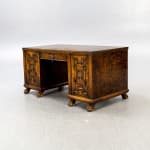






Axel Einar Hjorth
Further images
Swedish architect Axel Einar Hjorth was a major contributor to the burgeoning Swedish design culture that began to be recognized internationally in the 1920s. Hjorth’s designs from this period were inspired by neo-classism, often referred to as Swedish Grace.
Throughout the 1920s, Hjorth worked with various manufacturers including H. Joop & co, Myrstedt & Stern, Jonssons, and Svenska Möbelfabrikerna in Bodafors. Notably, in 1923 Hjorth was the head of the assembly section of the Jubilee Exhibition in Gothenburg—an exhibition which, the British critic P. Morton Shand characterized as the beginning of Swedish dominance in the decorative arts. Wishing to spread Swedish design further around the world, Hjorth, together with his contemporaries, Carl Hörvik (1882-1954) and Carl Malmsten (1888-1972), represented Stockholm at the exhibition of contemporary Swedish Decorative Arts at the Metropolitan Museum in New York 1927. This exhibition was instrumental in introducing Swedish decorative arts to America.
From 1927 until 1938, Hjorth was the chief architect and designer at the department store Nordiska Kompaniet (NK) in Stockholm—which was known as one of the most important producers of modernist furniture in Sweden.
Over the course of his career, Hjorth exhibited his works at many international exhibitions including the Stockholm Exhibition in 1930, the exhibition at the Dorland House in London in 1931, and the World Fairs in Chicago (1933), Brussels (1935), Paris (1937), and New York (1939). Hjorth also prepared and curated annual exhibitions for NK.
In the 1930s, Hjorth designed furniture out of pine meant for serial production for the summer houses he designed. These pieces mixed handicraft with international modernism, and were named for Stockholm's archipelago islands including Blidö, Sandhamn, Toro and Lovö.
Interior designer Pierre Yovanovitch uses Hjorth pieces in his projects. “I first discovered Hjorth’s Swedish Grace pieces on a visit to Stockholm’s Stadshus,” Yovanovitch explains. But I particularly like the raw furniture collection in Swedish pine he started to design in 1929 (when Swedish Grace was at its peak) known as Sportstugemöbler — ‘furniture for holiday houses.’ The collection is based on Swedish rural traditions, yet the works are astonishingly modern, displaying a delicate rigor in proportions, simplicity in construction, and a brilliant union between tradition and modernism.”
Hjorth's designs—from the luxuriousness of neo-classicism to the severity of functionalism—are sharply distinct in style, materials, and character.Join our mailing list
* denotes required fields
We will process the personal data you have supplied in accordance with our privacy policy (available on request). You can unsubscribe or change your preferences at any time by clicking the link in our emails.






